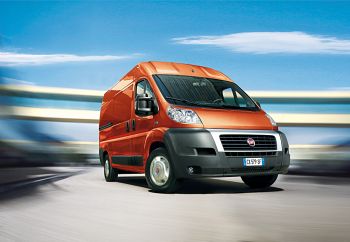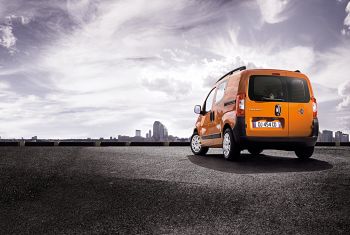
 |
|
Fiat Professional's two world previews make
their debut at the Hanover Show: Ducato
(top) and Fiorino Natural Power (above). Two
practical solutions and in perfect harmony
with the approach adopted by Fiat Group
Automobiles to environment related themes. |
|
|
|
Fiat
Professional's two world previews make their debut at
the Hanover Show: Ducato and Fiorino Natural Power. Two
practical solutions and in perfect harmony with the
approach adopted by Fiat Group Automobiles to
environment related themes.
In fact, the Group believes that
natural gas propulsion is the most appropriate and
immediately available technological choice today, in
order to resolve the pollution problems in urban areas.
This is because the use of natural gas produces a
positive impact in terms of environmental benefits (the
CO2 emissions are reduced by approximately 23% and
particulate emissions are virtually zero). Without
considering that the choice of natural gas, from the
economic aspect, is confirmed as a valid alternative to
conventional fuels (diesel and petrol) which are more
and more susceptible to price increases.
For the customer this means the
possibility of gaining access to all urban areas which
are subject to traffic limitations (associated with an
excess of polluting emissions), as well as also being
able to park the vehicle in garages in total safety. In
addition, the natural gas distribution networks are
becoming more and more widespread: for example, there
are currently more than 600 filling stations in Italy
with an expectation of approximately 100 new
distributors to be opened shortly.
Fiat Group Automobiles aims to
strengthen its position further in the field of natural
gas OEM vehicles with the Natural Power versions of the
Ducato and Fiorino models: the Fiat Professional brand
alone recorded 47% of the registrations of natural gas
fuelled commercial vehicles in Europe in 2007 (66.8% in
Italy). Fiat Professional is the leader in the 1B
segment, with Doblò Natural Power in particular, and has
a 45% market share in Europe. Now, it is the turn of the
natural gas-petrol versions of the Fiorino and Ducato to
contribute to these extraordinary results which have
been achieved to-date.
Ducato Natural Power
The general public can admire a Ducato Natural Power in
the Maxi Panel Van, medium wheelbase, high roof
configuration at Hanover (volume: 11.5 m3). The dual
fuel natural gas-petrol vehicle assures excellent
performance, limited consumption and above all minimum
emissions. The merit goes to the 3 litre engine that
develops a maximum output of 136 HP (100 kW) in the
natural gas mode from 2,750 to 3,500 r.p.m. and a
maximum torque of 350 Nm at 1,500 r.p.m. When using
natural gas fuel, the Ducato Natural Power version on
display on the stand reaches a maximum speed of 153
km/h; accelerates from 0 to 100 km/h in 13.9 seconds;
accelerates from 60 to 100 km/h (in 5th gear) in 10.1
seconds; can climb a 21.5% gradient; and, lastly,
consumes 9.3 kg of natural gas every 100 km. This engine
was developed and produced by FPT – Fiat Powertrain
Technologies: a solution that was produced to run on
natural gas from the initial design phases by adopting
various specific components to maximise the reliability
and efficiency when using both Compressed Natural Gas (CNG)
and petrol.
The vehicle is configured to operate
normally on natural gas, whereas the petrol mode
intervenes when the natural gas supply is running out.
Precisely in this latter situation the petrol tank (15
litres) assures a range that exceeds 100 km in the
‘recovery’ mode, in order to reach the nearest natural
gas supply station. The gas cylinders are located under
the floor, thereby maintaining full use of the loading
area. More in detail, the fuel system comprises 5 gas
cylinders: two 50 litre cylinders (equivalent to 8.5 kg
each) and three 40 litre cylinders (equivalent to 6.8 kg
each) providing an overall capacity of 220 litres
(corresponding to 37.4 kg) that assures a range of 400
km.
The natural gas is stored under
pressure inside the gas cylinders (200 bar nominal at
15°C), and flows into a special pipe to the pressure
reducer/regulator that supplies the 4 low-pressure
injectors (at approximately 7 bar). These are mounted on
the cylinder heads and are activated by the specific
electronic control unit. The control unit automatically
switches the fuel supply to the petrol mode if the
natural gas supply runs low.
Fiorino Combi Natural
Power
A prototype of the Fiorino Combi Natural Power is also
on show near the Ducato Natural Power with a dual
petrol/natural gas fuel supply; the two systems are
independent. The vehicle runs on natural gas and only
the engine start phase is always performed when in the
petrol mode, subsequently and automatically switching to
the other fuel system. In this way the petrol supply
system remains efficient and its intervention is only
required when the gas in the gas cylinders has almost
run out. The changeover from natural gas to petrol and
vice versa, however, can always be performed manually by
pressing a button on the dashboard.
The new vehicle is ideal for
transport services in urban areas - also thanks to its
compact dimensions -, has a minimum environmental impact
and is equipped with a 1.4 litre petrol engine that
adopts a Multipoint sequential phased system. This is a
distinctive technical feature that enables the engine to
achieve a performance comparable with the performance of
diesel engines when operating in the natural gas mode:
in fact, the maximum speed is approximately 150 km/h.
The Fiorino Combi Natural Power
ensures excellent drivability: the engine's maximum
output is 65 HP (48 kW) at 5,200 r.p.m. when running in
the natural gas mode, while the maximum torque is 104 Nm
at 2,600 r.p.m. Whereas, the performance is 73 HP (54
kW) at 5,200 r.p.m. and 118 Nm at 2,600 r.p.m.,
respectively, when the engine runs in petrol mode. The
Fiorino Combi Natural Power records minimum emissions:
the CO2 emissions correspond to 136 g/km in the natural
gas mode compared with 164 g/km when in the petrol mode.
The natural gas is stored in two
steel gas cylinders, positioned under the floor, which
have an overall capacity of 86 litres (corresponding to
approximately 15 kg of gas) and assure a maximum range
of 300 km, thanks to a consumption of 5 kg/100 km in the
combined cycle. In addition, the petrol tank (45 litres)
enables a further 600 km to be travelled: therefore, in
total, the overall range is a remarkable 900 km.
Lastly, the Fiorino Combi Natural
Power has a usable and regular luggage compartment, the
same as the diesel and petrol versions, differing from
the former versions by the presence of a flat support,
raised by only 120 mm, allowing small objects to be
stored inside. This support also characterises the Cargo
Natural Power version, enabling the loading area to
maintain the flat features for the full length.
|